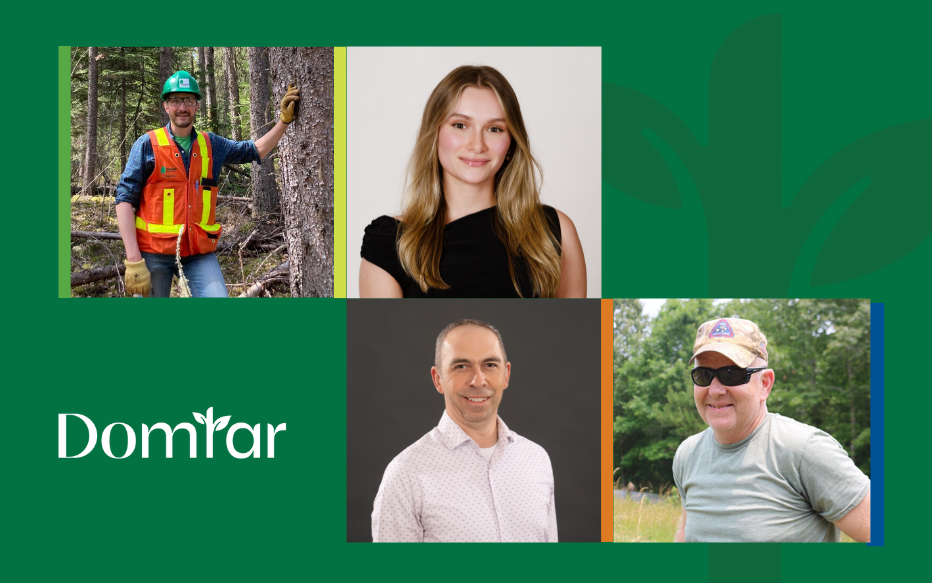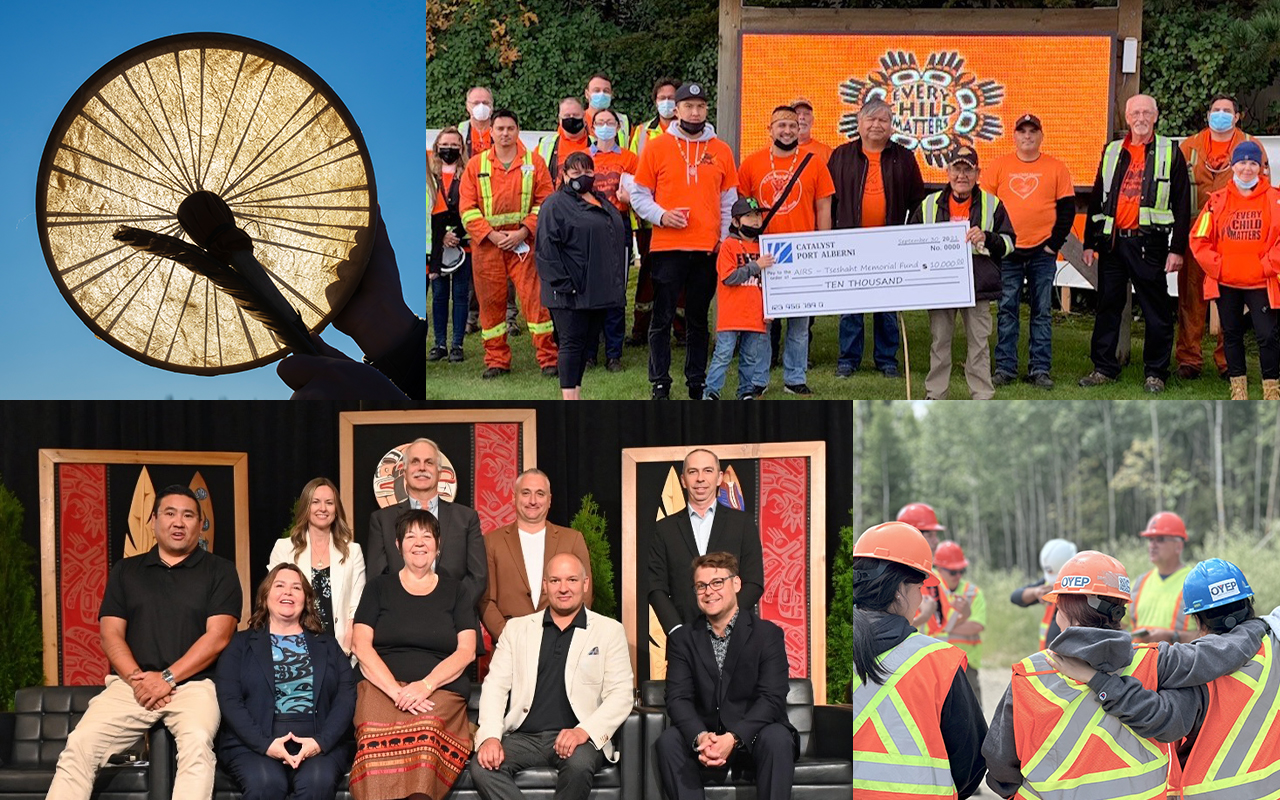It’s Forest Week, a time to celebrate the people who dedicate their careers to caring for our forests and to reflect on the vital role forests play in our environment, our economy and our daily lives. Forests sustain biodiversity, provide renewable resources and support thousands of jobs — including those of our own foresters and forest engineers.
At Domtar, our forest engineers are at the heart of sustainable forest management. From planning responsible harvests to protecting wildlife habitats, they help ensure our forests remain healthy and productive for generations to come.
We sat down with members of our forestry team for a behind-the-scenes Q&A for Forest Week. They shared what a day in the woods is really like. They also shared the challenges and rewards of their work, and what fuels their passion for forestry.
Jonathan Perron, Ing. F.
Forestry Senior Manager
Lac-Saint-Jean, Mauricie and Côte Nord Woodlands
Can you walk us through what a typical day looks like for you as a forest engineer?
“Fortunately, there’s no such thing as a typical day in my role. Each day brings new challenges, whether it’s harvest planning, ensuring forest operations meet standards, working with government, collaborating with other wood rights holders or engaging with First Nations and other stakeholders. Some issues can be resolved in just a few minutes, while others evolve into major projects that require strong commitment from our partners.”
What unique value do forest engineers bring to the forestry industry?
“This is definitely about our capacity to manage everything from the tree itself to the broader social purposes of forest management. Sometimes we have to make a decision that requires knowledge in biology, and other times we might lead a public consultation to gather input from the community on a project we want to move forward.”
What are the most rewarding and most challenging parts of your job?
“Sometimes positions related to forest management can seem very opposed and difficult to reconcile, requiring a great deal of effort to reach our goals. On the other hand, when we succeed in creating a process where everyone finds value and is committed to the project, it becomes one of the most rewarding outcomes possible.”
Laurence Caron, Ing. F.
Forest Engineer
Lac-Saint-Jean Woodlands
How do forest engineers contribute to sustainability and responsible forest management?
“Each forest engineer contributes to sustainability and responsible forest management in their own way depending on their job. Some design low-impact harvesting systems, others plan road networks to reduce environmental impact, and some focus on forest fire prevention and management. These are just a few examples of how forest engineers can make a difference. As for me, my main role is to ensure that all fieldwork complies with the laws and regulations that support sustainable and responsible forest use.”
How do you see the role of forest engineers evolving in the future?
“The demand for wood has existed for centuries and will continue for many more, especially since it’s a sustainable and ecological building material. I believe forest engineers will always have a role, though technological advances will simplify many of today’s tasks. For example, 20 years ago forest engineers worked mainly in the field, but now technology allows us to analyze forests from our computers — though we still need to be on site to verify things like an intermittent stream. In 20 years, maybe drones will handle that kind of work, but it’s hard to predict.”
Are you working on any exciting projects now?
“In October, I’ll be interviewed for the show Vie de chantier (which translates to Worksite Life) to talk about my work as a forest engineer at Domtar. The episode is expected to air later this year or in 2026. Since the show reaches hundreds of thousands of viewers across Quebec, it’s an exciting opportunity to share our work and tell our story.”
Chuck Daniels
Procurement Forester, Private Landowner
Plymouth Mill
What is your perspective as a forest industry forester and a private landowner?
“At Plymouth Mill, we are roughly 80 percent dependent on small landowner timber to source our mill. Twenty percent comes from large landowners, but the lion’s share of our wood basket is made up of small private landowners. All landowners are different. Some want to manage their land so they can have wildlife, protect natural water sources, host family events, enable tourism, whatever it may be. My soapbox is that when you’re managing for timber, you’re also benefitting all these other things. They’re complementary goals, not exclusive goals.”
How has being a landowner shaped your role as a forestry advocate?
“Being a landowner has opened the door to a lot of opportunities to act as a sustainable forestry advocate. My experience working at the mill, in addition to my experience as a forester, allows me to share a unique perspective with other landowners about exactly what happens to their fiber when it leaves their property. The forestry community is like a big family. I think other landowners appreciate my credibility because they know I also manage my own land.”
Charles-André Préfontaine, Ing. F.
General Manager
Lac-Saint-Jean and Mauricie Woodlands
What are the most rewarding and most challenging parts of your job?
“The great part of working with a renewable resource is that it renews itself. Every area we harvest grows back into a new forest, contributing to the natural cycle of the boreal forest ecosystem. Returning to an operating area a few years after harvesting and seeing the forest regrowing is one of the greatest satisfactions for a forester.
The most challenging part of my job is dealing with the misinformation surrounding forestry practices and their effects on ecosystems. Here in the Lac-Saint-Jean area, we have been managing and harvesting forests for over 200 years, and we plan to continue for another 200. Education is key to helping people understand the central role forest management plays in our local economy and in addressing climate change. Each year, we harvest less than 1 percent of the territory.”
Looking back, what professional milestones stand out most to you?
“I’ve had the chance to practice my profession at many different Domtar sites since I began my career, and every forest I’ve worked in or managed has been shared with local First Nations communities. Sharing the land also means sharing economic opportunities, and through my work I’ve been fortunate to participate in several initiatives with local communities by learning about their way of life while building partnerships and collaborations. In the Lac-Saint-Jean region, for example, our 10-year partnership with the Ilnu First Nation of Mashteuiatsh has created more than 100 jobs in our operations and provided business opportunity for woodland contractors for community members.”
Forestry is more than just managing trees. It’s about balancing ecological, economic and social priorities to ensure a sustainable future. At Domtar, this work is made possible by the expertise, passion and commitment of our forest engineers, who practice responsible forest management to ensure our forests continue to thrive and provide benefits for generations to come.






